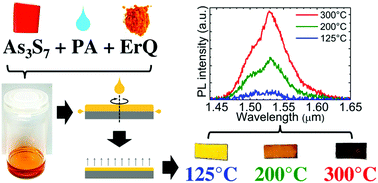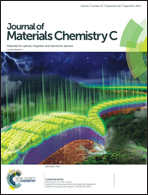Solution-processed Er3+-doped As3S7 chalcogenide films: optical properties and 1.5 μm photoluminescence activated by thermal treatment
Abstract
We report on the optical properties of Er-doped As3S7 chalcogenide films prepared using the two step dissolution process utilizing the As3S7 glass dissolved with propylamine and by further addition of the tris(8-hydroxyquinolinato)erbium(III) (ErQ) complex acting as an Er3+ precursor. Thin films were deposited by spin-coating, thermally stabilized by annealing at 125 °C and further post-annealed at 200 or 300 °C. The post-annealing of films at 200 °C and 300 °C densifies the films, improves their optical homogeneity, and moreover activates the Er3+:4I13/2 → 4I15/2 (λ ≈ 1.5 μm) PL emission at pumping wavelengths of 808 and 980 nm. The highest PL emission intensity was achieved for As3S7 films post-annealed at 300 °C and doped with ≈1 at% of Er which is beyond the normal Er3+ solubility limit of As–S melt-quenched glasses. The solution-processed deposition of the rare-earth-doped chalcogenide films utilizing the organolanthanide precursors has much potential for application in printed flexible optoelectronics and photonics.



 Please wait while we load your content...
Please wait while we load your content...